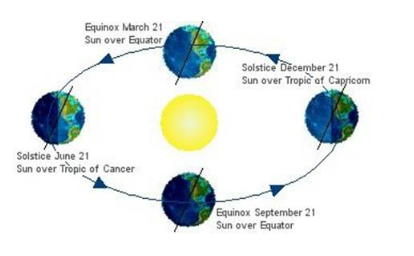Explain solstices and equinoxes with the help of a diagram.

The solstices and equinoxes are caused due to the position of the Earth with respect to the Sun on fixed days. The seasonal changes on the Earth are due to its revolution around the Sun.
- On 21st March and 23rd September, the sunrays are directly above the Equator. On these dates, the days and nights are of equal duration, i.e. of twelve hours each. This is known as equinoxes.
- On 21st June, the Northern Hemisphere is tilted towards the Sun. Since the direct rays of the Sun fall on the Tropic of Cancer, these areas receive more heat. The areas near the poles receive the slanting rays of the Sun and hence experience less heat of the Sun. Since the greater part of the Northern Hemisphere receives light from the Sun, it is summer in the places lying to the north of the Equator (Northern Hemisphere).
- On 21st June, the day is the longest and the night shortest in the Northern Hemisphere.
- The conditions are reversed in the Southern Hemisphere as it is tilted away from the Sun. The Sun’s rays do not reach the South Polar Regions beyond the Antarctic Circle. This marks the winter season in South Hemisphere.
- This is called summer solstice.
- On 22nd December, the Sun is directly above the Tropic of Capricorn. Since the South Pole is inclined towards the Sun, it is summer in the places lying south of the Equator (Southern Hemisphere).
- The conditions are reversed in the North Pole. Since it is tilted away from the Sun, it is winter here. 22nd December has the longest night and the shortest day in the Northern Hemisphere. It is known as the winter solstice.
- On 23rd September 23, the Sun is vertically above the Equator. The days and nights are equal at the Equator. It is autumn in the Northern Hemisphere and hence this day is called Autumnal Equinox. It is spring in the Southern Hemisphere at this time.
- On 21st March, it is spring in the Northern hemisphere and hence it is known as the Vernal Equinox.